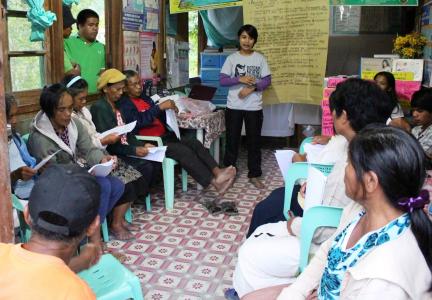The CorDisRDS has been initiating series of training, workshops and discussions related to Disaster Risk Reduction (DRR) in our program areas in the provinces of Abra, Benguet, Kalinga, Ifugao and Mountain Province. These activities enabled the members and officers of people’s organizations to understand the risks affecting their community and implemented activities to address or minimize risks. The series of training starts with a Community- based Disaster Risk Management Orientation wherein the primary topics are concepts of disasters, the root causes of vulnerabilities, climate change and hazards affecting the community, scope and phases of disasters and laws related to DRR. The main output is the formation of the disaster preparedness committee or the DPC. The DPC is responsible to plan and implement disaster preparedness activities based on the result of community risk assessment. Disaster Preparedness Training follows which is given primarily to disaster preparedness committee members and other key players in the community. The result of community risk assessment will be reviewed as basis of discussion and setting up of early warning system and evacuation plan. To complete the plan, a contingency planning workshop followed wherein a contingency plan per risk is prepared based on worst case scenario. A community drill concludes the training course wherein part of contingency plan is tested and to ensure that the actors can perform their task properly. This is done in coordination with the barangay officials, schools and other stakeholders inside the community especially in the preparation phase. From a scenario in the contingency plan, the whole community has to act according to the plan. After the community drill, an assessment will be conducted to determine what need to be done so that at-risk communities can be better prepared and know how what to do in cases of emergency situation.
This training course is observed in implementing the Building Resiliency of Indigenous Communities on Climate Change Adaptation (BRICCCA), a DRR program of Cordillera Disaster Response and Development Services (CorDisRDS) which is implemented in selected communities in Ifugao, Mt. Province and Abra. Particular in Uhaj, Banaue, Ifugao one of the BRICCA areas, a disaster preparedness committee was organized within the structure of Uhaj Farmers Organization (UFO). The officers of the organization and the DPC members appreciated the setting up of a committee though they said that they need to learn and familiarize with their duties and responsibilities. However, after the DPT and the Contingency Planning were finished, they confidently said that they can defend their lives, properties and resources against hazards by rebuilding their capacities such as having a strong community organization and relying on their traditional practices of mutual assistance. They are hopeful that the government is serious in implementing laws and programs that protect the environment, poverty alleviation and the rights of indigenous peoples. Levy Jane Mangili

